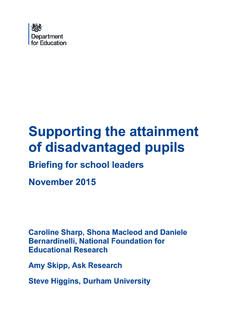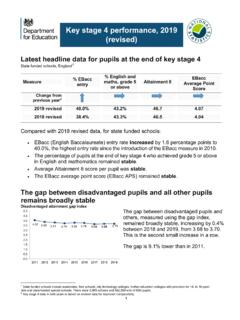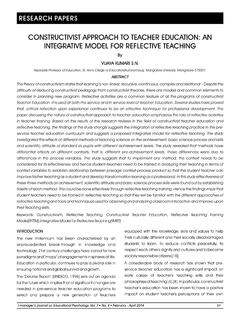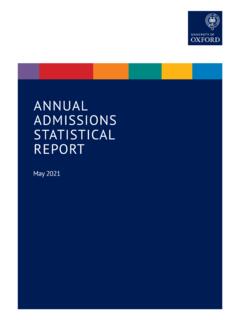Transcription of The Economic Impacts of Learning Losses - OECD
1 The Economic Impacts of Learning LossesEric A. HanushekLudger WoessmannSeptember 2020 AcknowledgementsThis paper benefitted from the encouragement and support of Andreas Schleicher and from his comments along with those of Macke Raymond, Michael Ward, and Francesco worldwide school closures in early 2020 led to Losses in Learning that will not easily be made up for even if schools quickly return to their prior performance levels. These Losses will have lasting Economic Impacts both on the affected students and on each nation unless they are effectively the precise Learning Losses are not yet known, existing research suggests that the students in grades 1-12 affected by the closures might expect some 3 percent lower income over their entire lifetimes. For nations, the lower long-term growth related to such Losses might yield an average of percent lower annual GDP for the remainder of the century.
2 These Economic Losses would grow if schools are unable to re-start Economic Losses will be more deeply felt by disadvantaged students. All indications are that students whose families are less able to support out-of-school Learning will face larger Learning Losses than their more advantaged peers, which in turn will translate into deeper Losses of lifetime present value of the Economic Losses to nations reach huge proportions. Just returning schools to where they were in 2019 will not avoid such Losses . Only making them better can. While a variety of approaches might be attempted, existing research indicates that close attention to the modified re-opening of schools offers strategies that could ameliorate the Losses . Specifically, with the expected increase in video-based instruction, matching the skills of the teaching force to the new range of tasks and activities could quickly move schools to heightened performance.
3 Additionally, because the prior disruptions are likely to increase the variations in Learning levels within individual classrooms, pivoting to more individualised instruction could leave all students better off as schools schools move to re-establish their programmes even as the pandemic continues, it is natural to focus considerable attention on the mechanics and logistics of safe re-opening. But the long-term Economic Impacts also require serious attention, because the Losses already suffered demand more than the best of currently considered re-opening OECD 2020 | The Economic Impacts of Learning LossesTable of contentsAcknowledgements ..2 Foreword ..3 Introduction ..5 Lost Learning during times of closed schools ..6 Economic effects of lost Learning ..7 Distributional issues ..10 Aggregate Losses in GDP across G20 nations.
4 10 Making up for Learning Losses ..11 Conclusions ..12 Annex A. Direct evidence on the effects of closed schools ..14 Annex B. Projection of costs from lower Economic growth ..16 Notes ..17 Bibliography ..19 Figure and TablesFigure 1 Days of schooling lost by mid-May 2020 ..7 Table 1 Lost individual income due to Corona-induced Learning loss ..9 Table 2 Long-run loss in GDP due to Corona-induced Learning loss ..10 Table 3 Present value of lost GDP due to Corona-induced Learning loss for G20 nations ..11 The Economic Impacts of Learning Losses | OECD 2020 5 IntroductionA central component of the Economic development policies of most countries has been investment in the human capital of society. Individuals with more skills are more productive and more adaptable to technological changes in their economies.
5 Nations with more skilled populations grow faster. In many countries, the reactions to the pandemic have, however, threatened the long-run future of the current cohort of students, and the harm to them from recent events can ripple through the world s economies in ways that will be felt far into the the potential health threats from the COVID-19 virus began to be understood at the beginning of 2020, schools in virtually all nations closed and sent their students home. Since then, public attention has rightfully focused on the immediate health and safety concerns surrounding schools, and nations are experimenting with alternate ways to proceed with their re-opening. Longer-run issues, however, have not received the same broader policy discussion has also focused on short-run issues. Policies introduced to fight the spread of the virus consisted of various degrees of business shutdowns and restrictions on movement and commerce.
6 Economic analysis has so far focused on the near-term impact of business closures on unemployment and on ways to provide safety nets for individuals directly harmed, but in doing so often leaves out consideration of longer-run , the urgency of dealing with the immediate and obvious issues of the pandemic has pushed aside any serious consideration of the longer-run costs of the virus-induced school closures. There is no doubt that the school closures in the first half of 2020 have resulted in significant Learning Losses to the affected cohort of students and some of the re-opening strategies being implemented will only further exacerbate these already incurred Learning Losses . These Losses will follow students into the labour market, and both students and their nations are likely to feel the adverse Economic can predict perfectly how school closures will affect the future development of the affected children, but past research has investigated how school attendance and Learning outcomes affect labour-market chances and Economic development.
7 This paper summarises the literature on the relationship between skills and years of schooling on the one 6 OECD 2020 | The Economic Impacts of Learning Losseshand, and individual and aggregate income on the other. In addition, it reviews previous studies of various examples of school closures and their long-term effects on the affected analysis suggests plausible ranges for the Economic impact of existing and on-going Learning Losses based on existing Economic research. The typical current student might expect something on the order of 3% lower career earnings if schools immediately returned to 2019 performance levels. disadvantaged students will almost certainly see larger Impacts . And, with the forecast of further disruptions in normal school operations, the costs only grow. For nations, the impact could optimistically be lower GDP throughout the remainder of the century and proportionately even lower if education systems are slow to return to prior levels of Losses will be permanent unless the schools return to better performance levels than those in 2019.
8 In this unprecedented period, there is of course great uncertainty about how to develop better schools, but two moves are suggested by existing research. First, large differences in effectiveness of teachers have been ubiquitous across schools. These differences are likely to be compounded as changes in the approach to schooling such as split shifts in schools and more video and dispersed instruction are introduced. Schools could improve if attention was given to using the teachers more effectively within and across media. Second, because the magnitude of Learning Losses will differ across students, teachers will face larger differences in preparations as the students return to their classes. More attention to individualising the instruction could elevate the Learning for all students and could act to ameliorate the Losses from prior closures by offering Learning opportunities matched to each Learning during times of closed schoolsFor many children and adolescents, no lessons were held in schools for at least some portion of the first half of 2020.
9 Figure 1 provides estimates of days of schooling lost to closure from an OECD/Harvard survey conducted in mid-May 2020, a time when the school term was not yet scheduled to end in most of these countries. While the details of closures require further investigation, these early estimates show substantial Losses in most countries. Additional Losses since that survey, as well as expected Losses into the future, can be expected to be much larger in most countries. Little is known about the effectiveness of Learning at home for the entire student population and what this means for the development of skills. However, there are indications from multiple countries that many children had little effective instruction. For a significant proportion of pupils, Learning during school closures was apparently almost non-existent.
10 For example, early tracking data from an online mathematics application used in a number of US school districts prior to COVID-19 suggest that the Learning progress of students has suffered a strong decline during the crisis, especially in schools in low-income areas (Chetty et al., 2020[1]). For Germany, a survey of parents of school children shows that the time that children spent on school-related activities per day was halved during the COVID-19 school-closure period, from to hours (Woessmann et al., 2020[2]). Indeed, 38% of students studied for school for no more than two hours per day, 74% for no more than four hours. By contrast, the time spent with TV, computer games, and mobile phones (passive activities) increased to hours per day. For children whose parents were more educated, the decline in school activities was similar to that of other children, although the increase in passive activities was slightly smaller.
















